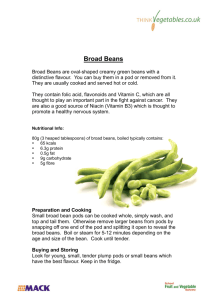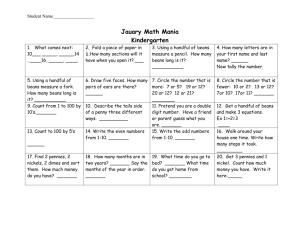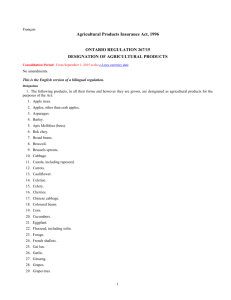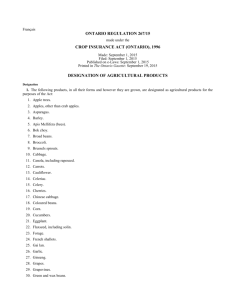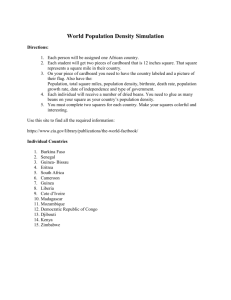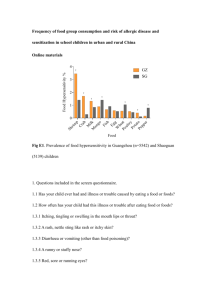Document 11039563
advertisement
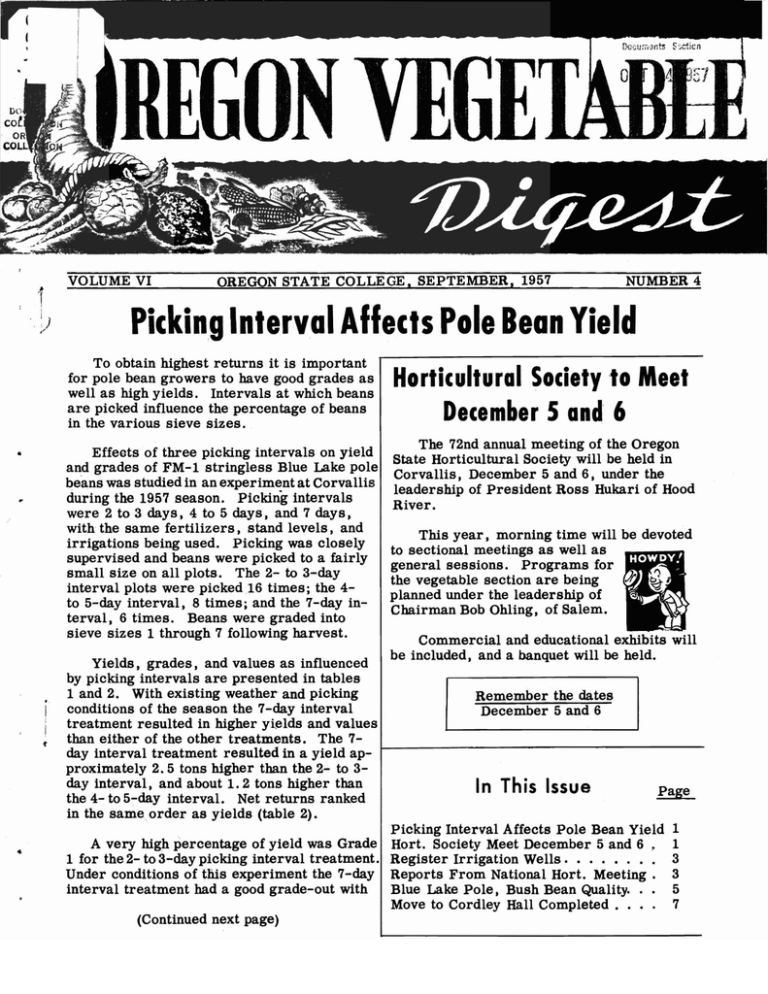
VOLUME VI iI ,,j " OREGON STATE COLLEGE. SEPTEMBER. 1957 Pickin,g Interval Affects Pole Bean Yield To obtain highest returns it is important for pole bean growers to have good grades as well as high yields. Intervals at which beans are picked influence the percentage of beans in the various sieve sizes. Effects of three picking intervals on yield and grades of FM-1 stringless Blue Lake pole beans was studied in an experiment at Corvallis during the 1957 season. Picking intervals were 2 to 3 days. 4 to 5 days. and 7 days. with the same fertilizers. stand levels. and irrigations being used. Picking was closely supervised and beans were picked to a fairly small size on all plots. The 2- to 3-day interval plots were picked16 times; the 4­ to 5-day interval. 8 times; and the 7-day in­ terval. 6 times. Beans were graded into sieve sizes 1 through 7 following harvest. • .. I , i t .. NUMBER 4 Yields. grades. and values as influenced by picking intervals are presented in tables 1 and 2. With existing weather and picking conditions of the season the 7-day interval treatment resulted in higher yields and values than either of the other treatments. The 7­ day interval treatment resulted in a yield ap­ proximately 2. 5 tons higher than the 2- to 3­ day interval. and about 1. 2 tons higher than the 4- to 5-:-day interval. Net returns ranked in the same order as yields (table 2). A very high percentage of yield was Grade 1 for the 2- to 3-day picking interval treatment. Under conditions of this experiment the 7-day interval treatment had a good grade-out with (Continued next page) Horticultural $ociety -to Meet December 5 and' 6 The 72nd annual meeting of the Oregon State Horticultural Society will be held in Corvallis. December 5 and 6. under the leadership of President Ross Hukari of Hood River. This year. morning time will be devoted to sectional meetings as well as general sessions. Programs for the vegetable section are being planned under the leadership of Chairman Bob Ohling. of Salem. Commercial and educational exhibits will be included. and a banquet will be held. Remember the dates December 5 and 6 In This Issue Page Picking Interval Affects Pole Bean Yield Hort. Society Meet December 5 and 6. Register Irrigation Wells. . . . . . .. Reports From National Hort. Meeting. Blue Lake Pole. Bush Bean Quality. .. Move to Cordley Hall Completed . . . . 1 1 3 3 5 7 2 Pole Bean Yield .•• (Continued from page 1) over 50% of the yield in Grade 1. (These grades are higher than average for our experimental plots.) Frequent picking every 2 to 3 days eVidently reduced yield. This lower yield cut net returns even though grades were very good. On the other hand, the 7-day interval treatment produced the highest yield and although grades were not as good as with the other treatments the increased yield did result in higher returns. These results are for one season only and different results may be expected in another 'season. Problems concerning supervision and pay for pickers would also have to be con­ sidered in determining the best picking interval for pole beans. Table 1. Yield and Grades of FM-1 Pole Beans as Affected by Picking Intervals. ) I I Picking, interval Tons Un raded I I p~r Tons per acre in grades* 2 4 3 1 acre Graded 9.0 8.7 7.62 0.71 0.31 0.06 4-5 days 10.5 9.9 7.32 1.62 0.74 0.22 7 days 11.7 11.2 6.33 3.01 1.37 0.49 2-3 days * Grade 1 - Sieve sizes 1, 2, 3; Grade 2 - Sieve size 4; Grade 3 - Sieve size 5; Grade 4 ­ Sieve sizes 6 and over. Table 2. Picking Interval Effects on Grades and Value of Pole Beans. * Total value Grades 1 Picking 4 3 2 Picking 'cost $ Net $ % $ % $ $ 1295. '8.2 106. 3.6 29. 0.6 4. 1434. 540. 894. 73.9 1244. 16.4 243. 7.5 70. 2.2 15. 1572. 630. 942. 56.5 1076. 26.9 451. 12.2 130. 4.4 32. 1689. 702. 987~ interval ':t> 2-3 days 87.6 4-5 ·days 7 days $ % $­ * Value based on.$170 per ton for Grade 1; $150 per ton for Grade 2; $95 per ton for Grade 3; and $65 for Grade 4. Picking cost ­ $60 per ton. --H. J. Mack A • Horticulture Department A Oregon's Vegetable Digest i~published Jour times a year by the Agricultural Experiment Station, Oregon State College, Corvallis. F. E. Price, Director. Address correspondence' to the author concerned or to the Department of Horticulture. Material may be reprinted providipg no endorsement of a commercial product is stated or implied. Please credit Oregon. State College. To simplify te<::hnical terminology, trade names of products or equipment som~times will be . used. No endorsement of products named is intended 'nor is criticism implied of products not mentioned. 3 Register Irrigation Wells Anyone using well water for irrigating should carefully note this information. Under the Ground Water Act of 1955, persons using wells for irrigation purposes prior to August 3, 1955 in western Oregon and May 20, 1927 in eastern Oregon, have a vested right and are given the opportunity to claim this right by registering their wells with the State Engineer before August 3, 1958. Lewis Stanley, State Engineer, estimates that considerably less than one-half the eligible wells have· been registered 80 far. (, Failure to register prior to August 3, 1958, is interpreted as abandonment of any priority claim. This could eventually cost present irrigators their right to use the well water for irrigation purposes. There already have been reports of wells going dry and water tables lowering in isolated cases. As ground water supplies become more completely developed, this situation will probably spread to other areas and there may not be enough water to go around. Contact the State Engineer, Salem, Oregon, immediately, for forms and instructions on how to register your well. His office is located on the third floor of the bUilding just east of the Capitol Building. --Marvin N. Shearer Irrigation Specialist £ A A 'Ii Reports From National H:ort. Meeting The 54th annual meeting of the American Society for Horticultural Science was held August 26-29 at Stanford University, Palo Alto, California. Here are a few "vegetable" highlights of papers presented by horticultural scientists from various sections of the country: Margaret M. and J. W. Lesley of the University of California reported that radio-isotope PJ2 was useful in obtaining male sterile tomatoes, of possible use for more efficient production of Fl hybrid tomato seed. T. Moulton J Purdue, reported inheritance of resistance to fruit cracking in tomatoes to be of moderate complexity, and also indicated that fruit size may not be associated with cracking. From Missouri, Lambeth reported on promising, disease resistant, greenhouse forcing tomatoes and Soost and Smith of California presented data on resistance to tobacco mosaic virus in the tomato. The tomato continues to be one of the most popular "guinea pigs" of plant scientists. C. E. Peterson and J. L. Weigle showed that a line of cucumbers producing female plants (only female flowers) may be highly useful in hybrid seed production. (Continued next page) 4 Report From National Meet... (Continued from page 3) From Michigan, P. M. Bessey and R. L. Carolus reported bitterness in carrots to be associated with maturity, packaging, and storage temperature, as well as variety and strain differences. R. L. Sawyer and S. L. Dallyn of Cornell showed that ionizing radiation could be used to control sprouting of onions, although dark growth (growing sprout) centers will develop, and further work is contemplated in attempting to control this undesirable effect. A. E. Thompson of Illinois reported that a high pigment tomato was promising for im­ proved color and consistency of puree. I From Cornell, Oyer and Minges reported severe losses to growers· in New York from premature heading of broccoli in 1956. Temperature and light effects on development of broccoli were studie'd in greenhouses. Relatively low temperatures and long days contributed to earlier heading. From Oregon State, Harry Mack reported on basal defoliation of beans; Jim Baggett on disease resistance in beans; and W. A. Frazier on hybridization of bush and pole beans. J. H. Kyle of Washington State reported "open micropyle, " as well as hard seed coat, as important factors in early germination of bean seeds. . S. H. Wittwer and M. J. Bukovac reported that induction of flowering and seed production in biennials in the absence of the usual requisite cold had been achieved in beets, carrots, .collards, kale, rutabagas, turnips J and several flower crops in Michigan by the use of Gibberellin. A positive relationship between tomato 'yields and percentage of water soluble phosphorus in·the fertilizers was ·found in a test by G. A. Bradley and J. W. Fleming of the University of Arkansas. The highest total yield of pickling cucumbers resulted from a 6-inch spacing in the row as compared to 12, 18, and 24 inches, in rows 5 feet apart in Michigan according to experiments conducted by S. K. Ries. A A A StfJIll e~"1 Vern Clarkson has accepted a research position with the Bakelite Corporation in North Carolina and will be leaVing about October 15. Clarkson has been doing research on paper and polyethylene mulches for horticultural crops during the past 3 years . • • • Dr. Garvin Crabtree should arrive about November 1, 1957 J from Cornell University to fill the position in weed control research formerly held by Roland Laning. He will be re­ sponsible for we~~ control work in vegetable crops, small fruits, and other phases of horti­ culture. 5~ BI!ue Lake Pole, Bu!sh Bean Quality Compared ,J i Quality of snap beans is largely determined by varietal characteristics and stage of ma­ turity. However, moisture levels, fertilizer levels, and weather may also influence such quality factors as color, shape, and fibrousness. With increasing maturity both seed ·co.n­ tent and fiber increase. Most regular bush beans develop a tough, fibrous sheath in the pod wall as the bean matures. Pods of the new Blue Lake-type hybrids are typically fleshy, low in percent seed, and largely . free from a fibrous sheath in pod walls. ;. While characteristically low fiber and percent seed contents are present in many new vari­ eties of regular bush beans, few app·roach the levels of Blue Lake hybrids. Since the quality standard of the Food and Drug Administration sets definite limits on percent fiber and seeds, this is an important characteristic to develop. The sub­ _~.J standard limits are 15% for fiber and 25% for seed. Many commercial lines and varieties tested in the variety testing program during recent years attain a fiber limit at low seed percentages. Thus ,per­ cent seed does not always correlate with fiber. Hot, dry weather rapidly in­ creases the fiber content of bush beans. Also, fiber content varies from year to year, usually because of weather. ~ Even though results of this year's work are not complete it was felt that this information would be of interest now to bush bean growers and processors. It is difficult to evaluate data on a group of hybrids because of differences in date of maturity, pod size ranges peculiar to individual selections, and pod shapes. Since all factors affecting quality of selections have not been pooled and evaluated, this report is confined to comparing the percent fiber and seed of two groups of bush beans. A representative cross section· of the two groups is· presented in the table. In all instances the beans were graded for size, after which sizes 3, 4 J and 5 were composited for processing. Fiber content would ordinarily be higher in bush beans to obtain as large a picking as possible. In pole beans, pickings are as frequent as possible to keep the sieve size small. Therefore, we would normally expect the fiber content of bush beans to be slightly higher, even though inherent characters of both types may be similar, except in factors controlling the pole versus bush habit. New Blue Lake-type bush beans develop very little fiber even in the larger sizes, com­ pared to regular bush beans. The optimum stage of maturity for" bush beans seems to occur when seed percentages reach about 4%. Because fiber content limits quality in most bush beans, these new Blue Lake lines are acceptable even in larger sizes. (Continued next page) '1Iu,etafJ.te1t~e," w. W. Hare of Mississippi State College reported in Phytopathology (Vol. 47) that re­ sistance to root-knot nematodes in peppers is controlled by a single genetic factor. Santanka x Sand 405B-Mexico were resistant varieties used in his study and crossed with several commercial bell pepper varieties. 6 Blue Lake Bean Qualify Comp1ared••• .I Blue Lake-type bush beans Regular bush beans Variety or number (Continued from page 5) Seed Fiber Percent Percent King Green 5. 06 • 0558 Northrup-King *103 4.40 Wadex I I Variety or number Seed .Fiber Percent Percent 411 (197) 5. 55 • 0199 .0874 836 5.49 .0157 6.15 .0972 538 6.03 .0198 B-3076 (USDA) 4.79 .0663 415 (194) 5.11 .0407 Green Pod '91 8.99 .0956 I 669 4.01 .0401 B-3034 (USDA). 2.83 .0981 816 4.01 .0361 Corneli 14 2.66 .0373 709 4.81 .0498 B-2135-4-5(USDA) 6.53 .1526 820 5.43 .0388 Woodruff Stringless Whiteseeded 6.73 .0718 549 3.87 .0180 FM-1 3.16 .0303 FM-1-1 3.08 .0270 Blue Lake Pole Beans As shown by percentage of seed J the bush beans J when compared to pole beans J were allowed to develop more of the larger sizes before harvest. However J fiber content of Blue Lake-type bush beans is comparable to pole beans. In future studies J more detailed comparisons involVing individual sieve sizes will be possible. --We A. Sistrunk Food and Dairy Technology Dept. W. A. Frazier -- Horticulture Dept. ~ ~ ~ 7. Move toCordley Hall Comp·leted .1 Experiment Station entomologists, plant pathologists, and horticulturists .are now housed in Cordley Hall, the new Agricultural Biological Science building. This building is located on Campus Way, just north of the Farm Crops building and east of Withycombe Hall and the old greenhouses. Horticulture is located on all four floors of the north wing, with the main office on the second floor. ( Plant Pathology occupies the south wing with the main office on the second floor. Names, room numbers, and telephone numbers follow for staff members in each department who deal with horticuitural crops. DEPARTMENT OF ENTOMOLOGY -. • Ritcher J PaulO. Every J R. W. .Crowell, H. H. Morrison, H. E. Terriere, L. C. Stephen, ·W. P. Rosenstiel, R. G. Jones, S. C. Swenson, K. G. Department Head Extension Entomologist Vegetable Insects Soil Insects, Symphylids Insect Toxicology Pollination, Bees Small Fruit Pests Tree Fruit Insects Insects of Ornamentals Greenhouse Crops Room No. 233 224 222 220 124 417B 438 231 218 Phone.No. 343 721 721 721 722 723 724 725 725 DEPARTMENT OF HORTICULTURE Apple, S. B. J Jr. Compton, o. C. Hansen.Elmer Hartman, Henry Zielinski, Q. B. Frazier, Wm. A. Mack, Harry Baggett, J. R. Roberts, A. N. Blaney, L., T. Clarkson, V. A. Wadsworth, S. E. Lagerstedt. Harry Clark. R. R. Rawlings, C. O. Painter, J. H. Waldo, George Department Head Tree Fruits Tree Fruits and Storage Tree Fruits and Storage Tree Fruits Vegetable Crops Vegetable Crops Vegetable Crops Ornamentals Ornamentals Small Fruits (Plastics) Floriculture Small Fruits Ext. Horticulturist Ext. Horticulturist USDA USDA Room No. 242B 454 450 448 452 340 346 344 352 350 354 232 136 148 150 138 144 Phone No '. 335 719 719 719 719 320 320 320 718 718 718 717 717 278 or 279 278 or 279 336 336 s Move to Cordley Hall Completed••• l (Continued from page 7) DEPARTMENT OF BOTANY AND PLANT PATHOLOGY ') Dietz, S. M. Belkengren, R. O. Cameron, H. R. Deep, I. W. Dobie, N. D. Jensen, H. J. Jones, L. E. McWhorter, F. P. MacSwan, i.c. Miller, P. W. Milbrath, J. A. Millsap, H. H. Vaughan, E. K. Young, R. A. Department Head Tree Fruits Tree Fruits Ornamentals Tree Fruits & Strawberries Nematode Problems Tree Fruits Ornamentals Ext. Plant Pathologist Strawberries Tree Fruits Ornamentals Small Fruits, Vegetables Ornamentals • • • Room No. 206 216 205 320 106 308 105 214 100 120 201 212 200 207 Phon~ No. 339 340 341 321 727 321 331 340 727 331 341 340 340 341


